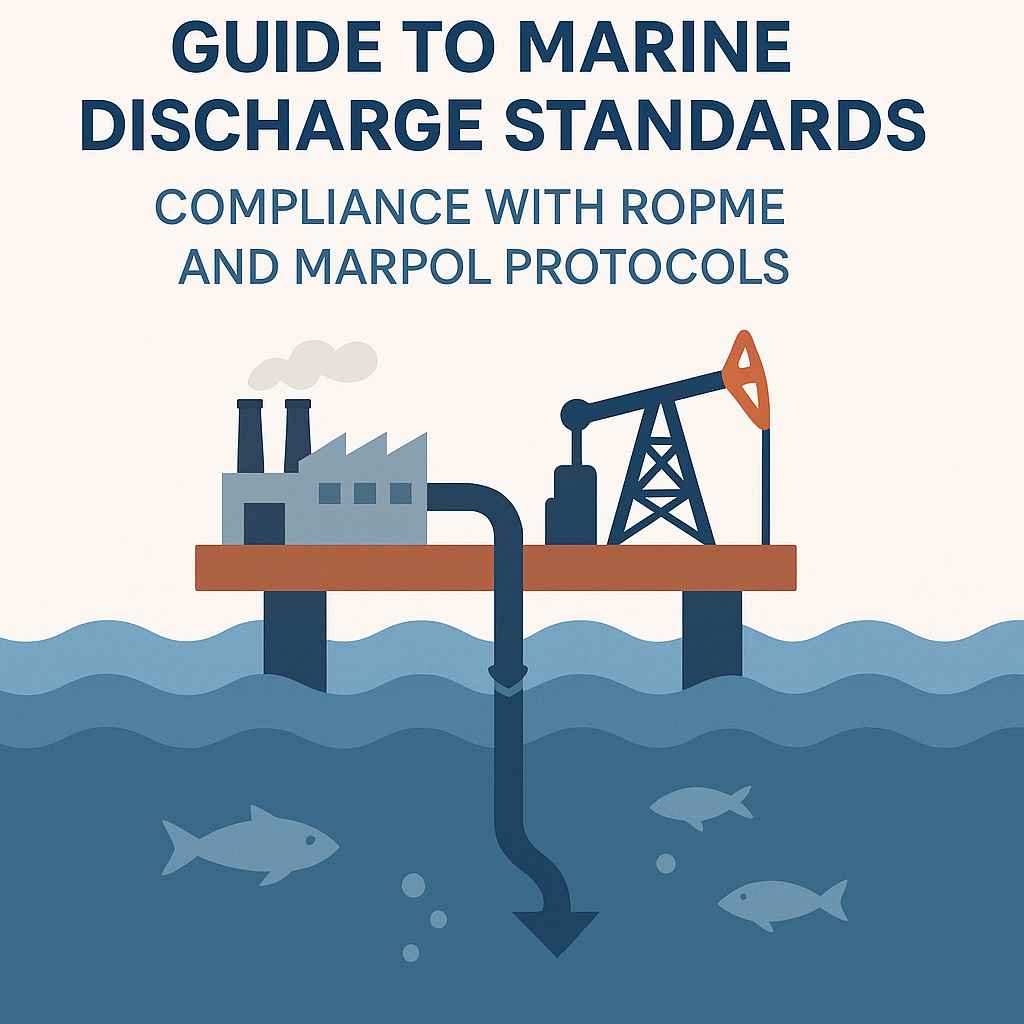This guide explains the minimum requirements for direct discharges into the marine environment from existing, new, and modified facilities, whether onshore or offshore. It covers applicability, key compliance measures, and international guidelines related to treated sanitary effluents, industrial wastewater, cooling water, brine, and offshore drilling operations—all aligned with international protocols such as ROPME and MARPOL 73/78.
Applicability of the Marine Discharge Standard
The standard regulates direct discharges into marine waters, including:
- Treated sanitary effluents
- Industrial wastewater
- Cooling water
- Brine discharges
- Offshore drilling operations
- Other direct discharges into marine environments
⚠️ Exclusions: Marine vessels are not included under this standard. They are regulated separately under the Regional Organization for the Protection of the Marine Environment (ROPME) Protocol and the International Convention for the Prevention of Pollution from Ships (MARPOL 73/78).
👉 For more details, you can review the International Maritime Organization’s MARPOL Convention.
Key Requirements for Marine Discharges
The standard establishes measures to minimize marine pollution and safeguard ecosystems by enforcing internationally recognized practices.
Design and Operation
- Wastewater Treatment: New and modified facilities must use advanced treatment technologies to reduce environmental impact.
- Sewage & Wastewater:
- Facilities near shorelines with large personnel must install advanced sewage treatment systems.
- Offshore facilities with fewer staff may use comminution without disinfection.
- Discharges must not create visible floating solids or discolor surrounding water.
- Solid Waste:
- Disposal of food waste within 12 nautical miles of land is prohibited.
- Beyond this distance, only comminuted food waste (through a 25 mm screen) is permitted.
- Rubbish such as plastics, paper, and trash is strictly banned from discharge.
- Drilling Operations:
- Oil-based drilling fluids are prohibited under the ROPME Protocol.
- Water-based fluids must be non-toxic, and drill cuttings must undergo toxicity testing before discharge.
- Other Operations: Activities like hydrotesting or dredging must comply with strict environmental guidelines to prevent marine contamination.
Monitoring, Sampling, and Verification
Facilities must monitor and verify discharge quality to ensure compliance:
- Monitoring Parameters: Residual chlorine, pH, and total coliform bacteria should be measured at the point of discharge.
- Records: Data logs must be maintained for environmental authority review.
- Exemptions: Comminuted-only discharges are exempt from detailed measurements but require visual checks for solids or discoloration.
- Analytical Methods: Testing must follow internationally recognized standards such as APHA and ASTM, with validation by accredited laboratories.
Effluent Discharge Limitations
Effluent limits align with ROPME and MARPOL protocols to protect marine ecosystems.
| Parameter | Max Limit (International Standard) | Notes |
|---|---|---|
| Floatables | None | No visible solids |
| pH | 6–9 units | Neutral balance |
| Total Suspended Solids | 15 mg/L | Prevent sedimentation |
| Turbidity | 75 NTU | Stricter in sensitive areas |
| BOD (Biochemical Oxygen Demand) | 25 mg/L | Minimize oxygen depletion |
| COD (Chemical Oxygen Demand) | 150 mg/L | Control organic load |
| Oil & Grease | 8 mg/L | Prevent surface films |
| Ammonia (as N) | 1.0 mg/L | Limit toxicity |
| Residual Chlorine | 0.5 mg/L | Reduce chemical impact |
| Mercury | 0.001 mg/L | Avoid bioaccumulation |
| Total Coliform | 1000 MPN/100 mL | Ensure sanitary safety |
Recommended Analytical Methods
| Parameter | APHA Method | ASTM Method |
|---|---|---|
| pH | – | D1293-84 |
| Turbidity | 2130-B | – |
| BOD | 5210-B | – |
| Oil & Grease | 5520-C | – |
| Ammonia (as N) | – | D1426-89 |
| Chlorine | 4500-Cl B, I, G | – |
| Total Coliform | 9221-B, C | – |
Compliance and Oversight
- Conflict Resolution: In cases of overlap, the stricter environmental protection protocol applies.
- Deviations: Any request for deviation requires approval from relevant environmental authorities.
- Sensitive Areas: Special assessments are mandatory before discharges in ecologically sensitive zones.
Conclusion
By aligning with ROPME and MARPOL protocols, this standard ensures that discharges from offshore and onshore facilities remain within strict environmental safeguards. Through advanced wastewater treatment, strict effluent limits, and continuous monitoring, industries can maintain sustainable operations while protecting fragile marine ecosystems.
👉 Learn more about sustainable compliance strategies in our Marine Environmental Standards Guide.

